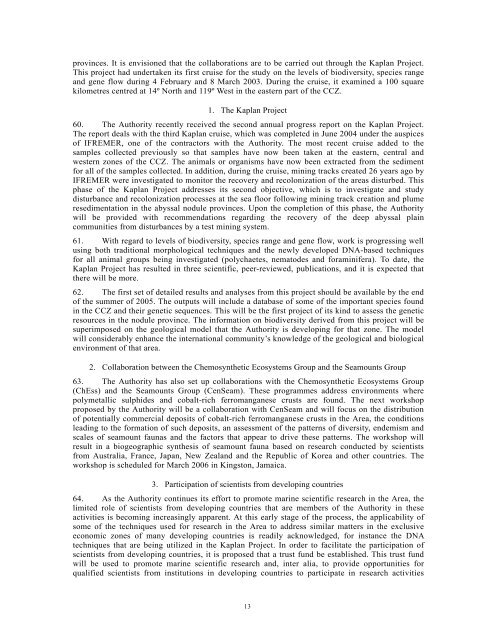Selected Decisions and Documents of the Eleventh Session
Selected Decisions and Documents of the Eleventh Session
Selected Decisions and Documents of the Eleventh Session
You also want an ePaper? Increase the reach of your titles
YUMPU automatically turns print PDFs into web optimized ePapers that Google loves.
provinces. It is envisioned that <strong>the</strong> collaborations are to be carried out through <strong>the</strong> Kaplan Project.<br />
This project had undertaken its first cruise for <strong>the</strong> study on <strong>the</strong> levels <strong>of</strong> biodiversity, species range<br />
<strong>and</strong> gene flow during 4 February <strong>and</strong> 8 March 2003. During <strong>the</strong> cruise, it examined a 100 square<br />
kilometres centred at 14º North <strong>and</strong> 119º West in <strong>the</strong> eastern part <strong>of</strong> <strong>the</strong> CCZ.<br />
1. The Kaplan Project<br />
60. The Authority recently received <strong>the</strong> second annual progress report on <strong>the</strong> Kaplan Project.<br />
The report deals with <strong>the</strong> third Kaplan cruise, which was completed in June 2004 under <strong>the</strong> auspices<br />
<strong>of</strong> IFREMER, one <strong>of</strong> <strong>the</strong> contractors with <strong>the</strong> Authority. The most recent cruise added to <strong>the</strong><br />
samples collected previously so that samples have now been taken at <strong>the</strong> eastern, central <strong>and</strong><br />
western zones <strong>of</strong> <strong>the</strong> CCZ. The animals or organisms have now been extracted from <strong>the</strong> sediment<br />
for all <strong>of</strong> <strong>the</strong> samples collected. In addition, during <strong>the</strong> cruise, mining tracks created 26 years ago by<br />
IFREMER were investigated to monitor <strong>the</strong> recovery <strong>and</strong> recolonization <strong>of</strong> <strong>the</strong> areas disturbed. This<br />
phase <strong>of</strong> <strong>the</strong> Kaplan Project addresses its second objective, which is to investigate <strong>and</strong> study<br />
disturbance <strong>and</strong> recolonization processes at <strong>the</strong> sea floor following mining track creation <strong>and</strong> plume<br />
resedimentation in <strong>the</strong> abyssal nodule provinces. Upon <strong>the</strong> completion <strong>of</strong> this phase, <strong>the</strong> Authority<br />
will be provided with recommendations regarding <strong>the</strong> recovery <strong>of</strong> <strong>the</strong> deep abyssal plain<br />
communities from disturbances by a test mining system.<br />
61. With regard to levels <strong>of</strong> biodiversity, species range <strong>and</strong> gene flow, work is progressing well<br />
using both traditional morphological techniques <strong>and</strong> <strong>the</strong> newly developed DNA-based techniques<br />
for all animal groups being investigated (polychaetes, nematodes <strong>and</strong> foraminifera). To date, <strong>the</strong><br />
Kaplan Project has resulted in three scientific, peer-reviewed, publications, <strong>and</strong> it is expected that<br />
<strong>the</strong>re will be more.<br />
62. The first set <strong>of</strong> detailed results <strong>and</strong> analyses from this project should be available by <strong>the</strong> end<br />
<strong>of</strong> <strong>the</strong> summer <strong>of</strong> 2005. The outputs will include a database <strong>of</strong> some <strong>of</strong> <strong>the</strong> important species found<br />
in <strong>the</strong> CCZ <strong>and</strong> <strong>the</strong>ir genetic sequences. This will be <strong>the</strong> first project <strong>of</strong> its kind to assess <strong>the</strong> genetic<br />
resources in <strong>the</strong> nodule province. The information on biodiversity derived from this project will be<br />
superimposed on <strong>the</strong> geological model that <strong>the</strong> Authority is developing for that zone. The model<br />
will considerably enhance <strong>the</strong> international community’s knowledge <strong>of</strong> <strong>the</strong> geological <strong>and</strong> biological<br />
environment <strong>of</strong> that area.<br />
2. Collaboration between <strong>the</strong> Chemosyn<strong>the</strong>tic Ecosystems Group <strong>and</strong> <strong>the</strong> Seamounts Group<br />
63. The Authority has also set up collaborations with <strong>the</strong> Chemosyn<strong>the</strong>tic Ecosystems Group<br />
(ChEss) <strong>and</strong> <strong>the</strong> Seamounts Group (CenSeam). These programmes address environments where<br />
polymetallic sulphides <strong>and</strong> cobalt-rich ferromanganese crusts are found. The next workshop<br />
proposed by <strong>the</strong> Authority will be a collaboration with CenSeam <strong>and</strong> will focus on <strong>the</strong> distribution<br />
<strong>of</strong> potentially commercial deposits <strong>of</strong> cobalt-rich ferromanganese crusts in <strong>the</strong> Area, <strong>the</strong> conditions<br />
leading to <strong>the</strong> formation <strong>of</strong> such deposits, an assessment <strong>of</strong> <strong>the</strong> patterns <strong>of</strong> diversity, endemism <strong>and</strong><br />
scales <strong>of</strong> seamount faunas <strong>and</strong> <strong>the</strong> factors that appear to drive <strong>the</strong>se patterns. The workshop will<br />
result in a biogeographic syn<strong>the</strong>sis <strong>of</strong> seamount fauna based on research conducted by scientists<br />
from Australia, France, Japan, New Zeal<strong>and</strong> <strong>and</strong> <strong>the</strong> Republic <strong>of</strong> Korea <strong>and</strong> o<strong>the</strong>r countries. The<br />
workshop is scheduled for March 2006 in Kingston, Jamaica.<br />
3. Participation <strong>of</strong> scientists from developing countries<br />
64. As <strong>the</strong> Authority continues its effort to promote marine scientific research in <strong>the</strong> Area, <strong>the</strong><br />
limited role <strong>of</strong> scientists from developing countries that are members <strong>of</strong> <strong>the</strong> Authority in <strong>the</strong>se<br />
activities is becoming increasingly apparent. At this early stage <strong>of</strong> <strong>the</strong> process, <strong>the</strong> applicability <strong>of</strong><br />
some <strong>of</strong> <strong>the</strong> techniques used for research in <strong>the</strong> Area to address similar matters in <strong>the</strong> exclusive<br />
economic zones <strong>of</strong> many developing countries is readily acknowledged, for instance <strong>the</strong> DNA<br />
techniques that are being utilized in <strong>the</strong> Kaplan Project. In order to facilitate <strong>the</strong> participation <strong>of</strong><br />
scientists from developing countries, it is proposed that a trust fund be established. This trust fund<br />
will be used to promote marine scientific research <strong>and</strong>, inter alia, to provide opportunities for<br />
qualified scientists from institutions in developing countries to participate in research activities<br />
13
















